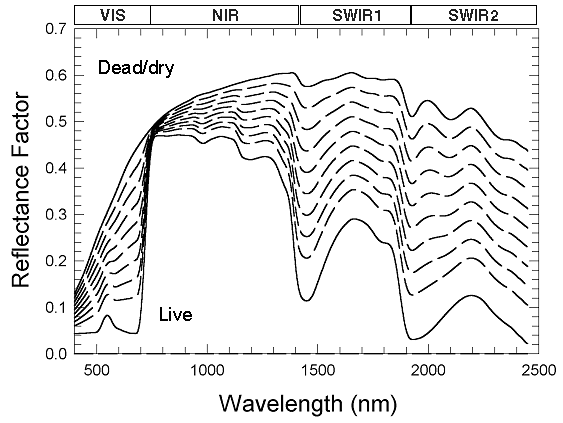The previous sections primarily discuss live, green vegetation, but many ecosystems contain as much, or more, senescent or dead vegetation (also known as non-photosynthetic vegetation, or NPV) as they do green vegetation. Examples include grasslands, shrublands, savannas, and open woodlands, which collectively cover over half of the global vegetated land surface. This material is often called non-photosynthetic vegetation because it could be truly dead or simply dormant (such as some grasses between rainfall events). Also included in the NPV category are woody structures in many plants, including tree trunks, stems, and branches.
NPV is composed largely of the carbon-based molecules lignin, cellulose, and starch. As such, it has a similar reflectance signature to these materials, with most of the variation in the shortwave infrared range. In many canopies, much of the NPV is obscured below a potentially closed leaf canopy; the wavelengths used to measure NPV (shortwave infrared) are often unable to penetrate through the upper canopy to interact with this NPV. As such, only exposed NPV has a significant effect on the spectral reflectance of vegetated ecosystems. When exposed, NPV scatters photons very efficiently in the shortwave infrared range, in direct contrast to green vegetation which absorbs strongly in the shortwave infrared range.
In general, photons in the visible wavelength region are efficiently absorbed by live, green vegetation. Likewise, photons in the SWIR-2 region of the spectrum are efficiently absorbed by water. In contrast to live vegetation, dead, dry, or senescent vegetation scatters photons very efficiently throughout the spectrum, with the most scattering occurring in the SWIR-1 and SWIR-2 ranges. The change in canopy reflectance due to increasing amounts of NPV is shown in the following figure.

Reference
Asner, G.P., 1998, Biophysical and Biochemical Sources of Variability in Canopy Reflectance, Remote Sensing of Environment, 64:234-253.
See Also
Spectral Indices, Vegetation Indices, Vegetation Analysis Tools, Vegetation and Its Reflectance Properties